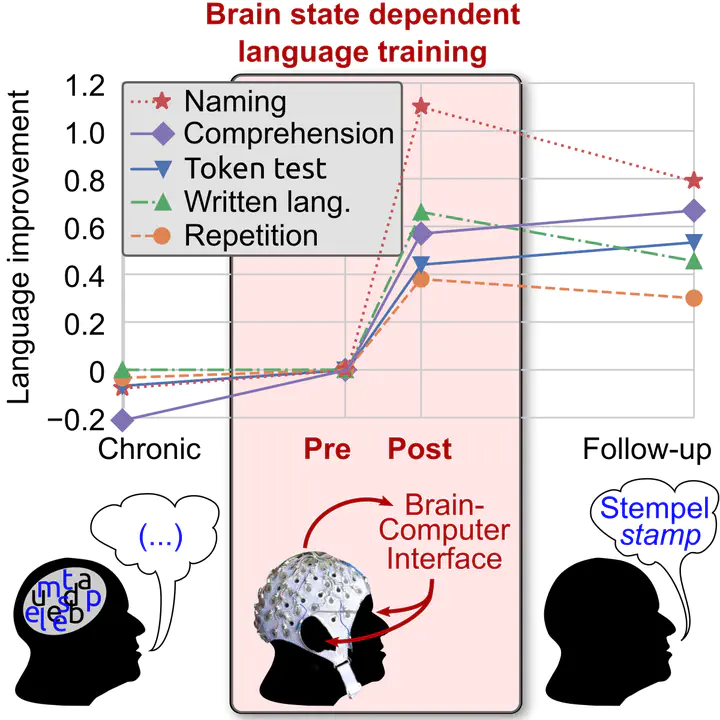BCI-supported language rehabilitation
Novel training approach for stroke patients with aphasia.
 Graphical abstract of BCI-supported language training
Graphical abstract of BCI-supported language training
Summary
Aphasia, the impairment to understand or produce language, is a frequent disorder after stroke with devastating effects. Conventional speech and language therapy include each formal intervention for improving language and communication abilities. In the chronic stage after stroke, it is effective compared with no treatment, but its effect size is small. We present a new language training approach for the rehabilitation of patients with aphasia based on a brain–computer interface system. The approach exploits its capacity to provide feedback time-locked to a brain state. Thus, it implements the idea that reinforcing an appropriate language processing strategy may induce beneficial brain plasticity. In our approach, patients perform a simple auditory target word detection task whilst their EEG was recorded. The constant decoding of these signals by machine learning models generates an individual and immediate brain-state-dependent feedback. It indicates to patients how well they accomplish the task during a training session, even if they are unable to speak. Results obtained from a proof-of-concept study with 10 stroke patients with mild to severe chronic aphasia (age range: 38–76 years) are remarkable. First, we found that the high-intensity training (30 h, 4 days per week) was feasible, despite a high-word presentation speed and unfavourable stroke-induced EEG signal characteristics. Second, the training induced a sustained recovery of aphasia, which generalized to multiple language aspects beyond the trained task. Specifically, all tested language assessments (Aachen Aphasia Test, Snodgrass & Vanderwart, Communicative Activity Log) showed significant medium to large improvements between pre- and post-training, with a standardized mean difference of 0.63 obtained for the Aachen Aphasia Test, and five patients categorized as non-aphasic at post-training assessment. Third, our data show that these language improvements were accompanied neither by significant changes in attention skills nor non-linguistic skills. Investigating possible modes of action of this brain–computer interface-based language training, neuroimaging data (EEG and resting-state functional MRI) indicates a training-induced faster word processing, a strengthened language network and a rebalancing between the language- and default mode networks.
Challenges
From bench to bedside This project makes use of multiple years of experience with auditory BCI protocols. To make the patient training feasible, however, the software and the training protocol had to reach a high level of robustness and usability both for the participating stroke patients as well as for our experimenters.
Non-stationary features The informative features of the EEG signal can change over time, thus violating the i.i.d. assumptions made by most machine learning models. Within a training session of our protocol, this could be caused by, e.g., fatigue or sensor problems. Over multiple sessions, patients managed to better solve the word task, e.g., due to improved use of the language network or changed strategies to accomplish the task. We as experimenters also contributed to the non-stationarity by increasing the task difficulty once a patient reached a stable performance. To cope with non-stationarity, we used an adaptive binary classification approach that updated the decoding model after every run.
Transfer learning A classification model trained to decode the word-evoked ERP responses of a patient on data of one session had to be transfered to and immediately applied in the following online training session.
Understanding the training effect While we could show the effectiveness of the novel language training, a future randomized controlled study is required to show, if indeed the use of the BCI plays a crucial role in supporting the language improvements observed.
Patient subgroups A follow-up study with more patients may unravel, if certain subgroups of stroke patients with aphasia profit more or less from the novel rehabilitation intervention.
Introspection Providing targeted feedback to the patients and introspection possibilities to clinicians required a clear understanding of the BCI’s classification models and EEG features extracted for this purpose. For this reason we refrained from using black-box machine learning models such as deep neural networks and reverted to linear classification with strong regularization.
Collaboration
This project is a collaborative endeavour with Mariacristina Musso of the Dept. for Neurology and Neurophysiology of the University Medical Center of the University of Freiburg, Germany, among others.
Key publications / awards
-
(2022). Aphasia recovery by language training using a brain--computer interface: A proof-of-concept study. Brain communications.
- Our work was granted the International BCI Award 2018 (2nd place)